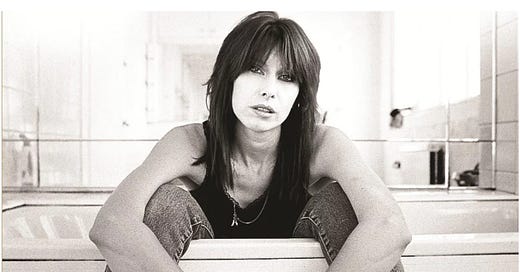In keeping with my decision to focus the rest of this year’s posts on women in music, I am starting a series on the history of women in rock. I have previously posted several times on various female rock musicians. This is my attempt to take a more systematic and in depth look at the history. I started with artists who were already among my favorites, but I am interested in expanding the list. I want this to be a community effort. So if, after reading this or any future installment, you have suggestions of artists I should look at, please put them in the comments!
We sometimes forget that rock music was the dominant form of popular music worldwide for almost half a century. Starting from its origins in the U.S. and U.K., it took root around the world, often against determined resistance from whatever constituted the local establishment (many jurisdictions and even whole countries sometimes went so far as to ban it, including cities here in the U.S.) While rock was becoming global, it remained anchored in the U.S. and U.K. Musical trends and fashions in rock were largely defined by what was happening here. (That would eventually start to change around the turn of the millennium—an important shift and one I will address in detail later.)
In its early days, rock music in the U.S. featured a number of prominent and influential women. Some of them were among the biggest stars of their time. Then, they largely vanished from the scene. By the late 1980’s, rock had become a male-dominated genre, and rock as something guys did became the stereotype. The commercial rock scene in the West today remains rampantly sexist (as does the popular music industry in general, including the biggest new genre, hip-hop). For almost four decades now, women in American popular music have stayed within their more traditional lanes as singers and songwriters. Some of them are enormously successful, but very few of them are doing rock music.
However, what is happening in British/American rock no longer defines the rules. Rock’s popularity has declined precipitously in its lands of origin, but it has been experiencing a major revival in other parts of the world, especially in Scandinavia, Eastern Europe, South America, and parts of Asia. One striking and important aspect of this revival is the leading role of women, not just as singers, but as composers, instrumentalists and bandleaders. “Girls don’t play the guitar” used to be a common trope, and that is still the conventional wisdom in the U.S., but women around the world are not only playing guitars (and every other instrument) but are setting new standards for instrumental virtuosity, which was a hallmark of the great rock acts of the 1960’s, ‘70’s and ‘80’s. Along the way, women are transforming genres of music once seen as irreducibly masculine, like thrash, punk and heavy metal.
I’ll be exploring the history of women in rock, and how the pioneers set the stage for some of the women leading today’s charge. At the risk of pissing some people off, I will address the question of how these women over time have confronted, and are confronting, sexism and sexist stereotypes. Along the way, I also ask why women have largely surrendered the field of rock music in the U.S., which is arguably the most self-consciously “woke” country of all. Some people dismiss pop culture as superficial when weighed against bigger questions of gender roles in society, but I think they’re wrong. Pop culture not only reflects who we think we are, but shapes who we think we are. So even as women are dominating in academia and in many professions once considered the domain of men, why have they retreated into traditional roles in popular music?
Future installments in this series will contain lots of links to music. Here I leave you with just one. Chrissie Hynde and the Pretenders represent, for me, the high-water mark for women in rock in the U.S. One could do a PhD dissertation on their music and history and what it all meant. I will go into some of that in later posts. For now, I’ll just mention that this performance came thirty-two years after she founded the band, and twenty-seven years after two of the original band-members died of drug overdoses. Most of her bandmates in this performance are young enough to have been her children. The exception is drummer Martin Chambers, the other surviving member of the original lineup. When asked what it was like working with Chrissie all these years, he said “As long as you do what she says, it’s all good!”
“Back on the Chain Gang” (Live in London, 2010)




What an amazing performance that was! I had no idea Chrissie was still at it! And, the fact that she, apparently, hasn't gained a single pound (or inch around the waist) is jaw-dropping, as well! And, good on ya, Charles, for tackling the rock ladies👩🎸! A daunting task, and I look forward to the upcoming chapters!🎼🎵👍